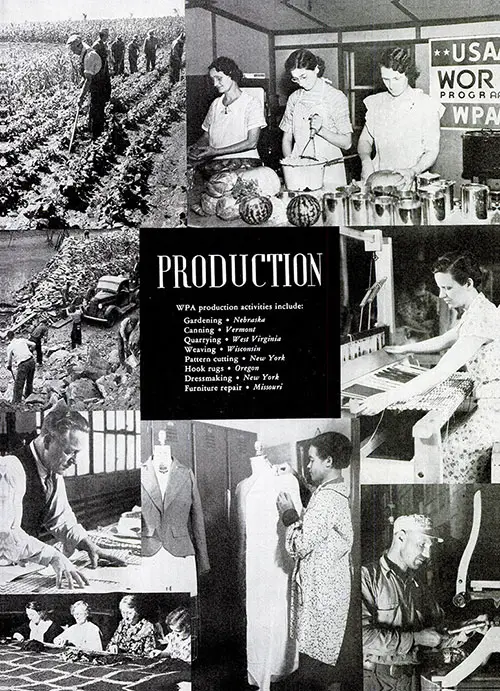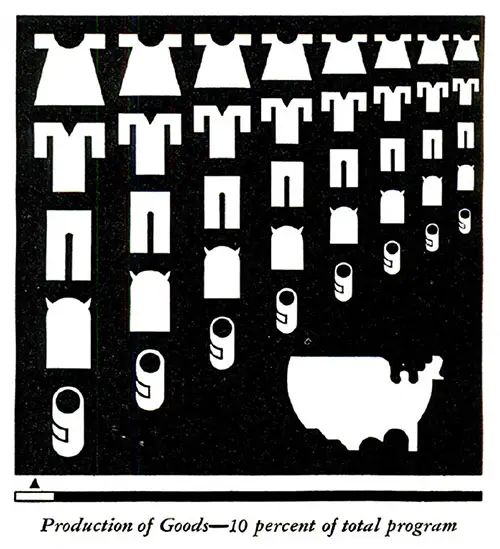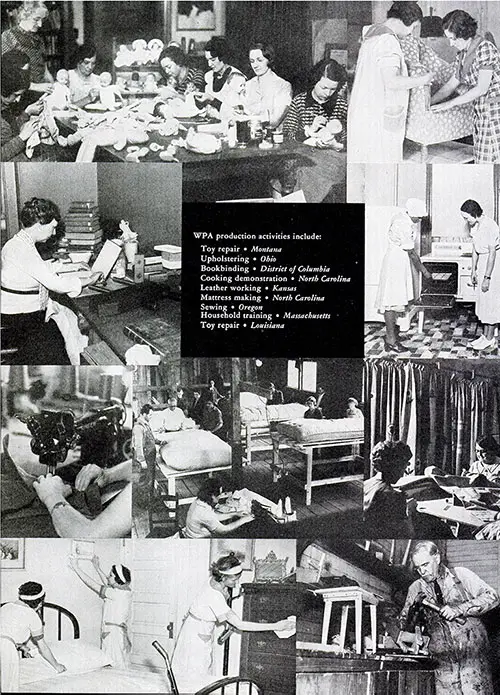WPA Production Activities - 1938

WPA Production Activities Include Gardening (Nebraska), Canning (Vermont), Quarrying (West Virginia), Weaving (Wisconsin), Pattern Cutting (New York), Hook Rugs (Oregon), Dressmaking (New York), Furniture Repair (Missouri). Inventory: An Appraisal of Results of the Works Progress Administration, Washington, DC: US Government Printing Office, 1938. GGA Image ID # 152216c741
Thousands of American communities, to provide employment for women and other persons unsuited either for heavy construction or professional work, have sponsored WPA projects for the production of goods and materials. Such work represents about 10 percent of the entire program.

Production of Goods—10 Percent of Total Program. Inventory: An Appraisal of Results of the Works Progress Administration, Washington, DC: US Government Printing Office, 1938. GGA Image ID # 1522aa40e1
These projects, whether they produced garments or preserved surplus food for free distribution among those unable to buy these necessities, serve the triple purpose
(1) of sustaining the workers,
(2) of saving or improving their ability, and
(3) of reducing the public relief bill to the extent of what these products would have cost.
By far the largest of such groups are the 10,259 WPA sewing rooms in which a small army of needy women, either heads of families or single and "on their own," have produced more than 121,700,000 articles for free distribution by public agencies among the destitute or to tax-supported institutions.
These articles include more than 95,000,000 garments such as shirts, dresses, and under- wear. More than 17,000,000 of these have been for men, nearly 25,000,000 for women, 16,000,000 for boys, 22,000,000 for girls, and 16,000,000 for infants.
Other articles include large quantities of sheets, towels, pillowcases, and other linens, while many opportunities have been offered to develop special skills in needlework, weaving, and knitting.
While remarkable ingenuity has been displayed in producing serviceable and attractive garments and articles out of such humble materials as sacking, these projects also have made substantial textile purchases from private industry.
These aggregated over $40,500,000 through October 31, 1937, or nearly 8 percent of the agency's total expenditure for materials, supplies, and equipment. Sewing rooms range in size from modern plants employing hundreds of women to small centers with ten or a dozen workers, depending upon community needs and the number of eligible women available.
All types of clothing are made, from baby layettes to heavy coats and overalls. The training often includes lessons in the se- lection of materials, tailoring, economy in cutting, and the proper care of clothing.
Many of the women, previously untrained, are equip- ping themselves not only to supply the needs of their own families, but also to hold private jobs. With the workers available through the WPA, many communities have set up seasonal canning and preserving projects to save surplus fruit, vegetables, and meat for relief distribution which otherwise would have been wasted.
Thus large quantities of surplus meat have been saved, while in fruit- and truck-farming areas, during peak seasons, much valuable food has been gathered and processed. The variety has ranged from surplus fish in Maine to molasses in the South.
The products of thousands of WPA subsistence gardens, and other gardens operated to supply school lunch projects, also have been preserved. In all, WPA workers have canned or pre- served more than 36,000,000 pounds of food- stuffs.
To distribute these products, as well as over 675,000,000 pounds of foodstuffs made available by the Federal Surplus Commodities Corporation, required still more WPA personnel. As a result, hundreds of workers have carried out this task for welfare agencies in many communities.
They have distributed, in addition to the foods mentioned above, more than 82,000,000 quarts of milk in liquid or powdered form and nearly 572,000 cords of wood. Here again, the cost of the services performed by these WPA workers otherwise would have fallen upon local resources, or the work would not have been done.
In the same general field, workers on shoe and furniture repair projects have collected and re- habilitated over 600,000 pairs of shoes and nearly 900,000 pieces of furniture, subsequently used by people on relief.
The WPA has enrolled over 15,000 women in training courses for private jobs in the field of household employment. This program, under which capable and reliable women are trained to perform the various duties of the skilled household worker, is designed to raise the standards of the occupation on the part of both employer and employee.
It aims also to place those who successfully complete the training in homes of employers who maintain reasonable standards of work, living conditions, and pay.
Perhaps the most interesting type of goods project which the WPA has been asked to provide is that which renews and preserves age-old arts and crafts, almost lost in this machine age. In many areas where hand-wrought goods are a tradition, where native materials are used and an older generation still cherishes the patterns and the lore, WPA workers are reviving native handicrafts.
The immediate purpose is production of needed articles for hospitals and other public institutions, but the hope is that renewed popular interest in these crafts will make the workers self-supporting. In fact, a substantial number already have left the rolls.
Almost an entire New Mexico village went "off relief" because of the demand for Moorish period furniture produced in its WPA community workshop—furniture authentically copied from that of the early Spanish settlers.
Many of the 40,000 objects and articles thus produced have attracted wide attention . . . Mexican drawn work and lace in the Southwest, Spanish colonial homespun rugs in Colorado, old English homespun linens in Virginia, Indian beadwork and leathercraft, hammered copper, fine pottery, basketry, woodwork, and metalcrafts.

Additional WPA Production Activities Include Toy Repair (Montana), Upholstering (Ohio), Bookbinding (District of Columbia), Cooking Demonstration (North Carolina), Sewing (Oregon), Household Training (Massachusetts), Toy Repair (Louisiana). Inventory: An Appraisal of Results of the Works Progress Administration, Washington, DC: US Government Printing Office, 1938. GGA Image ID # 1522a4acf2
"Production," in Inventory: An Appraisal of Results of the Works Progress Administration, Washington, DC: US Government Printing Office, 1938, pp. 55-58.

